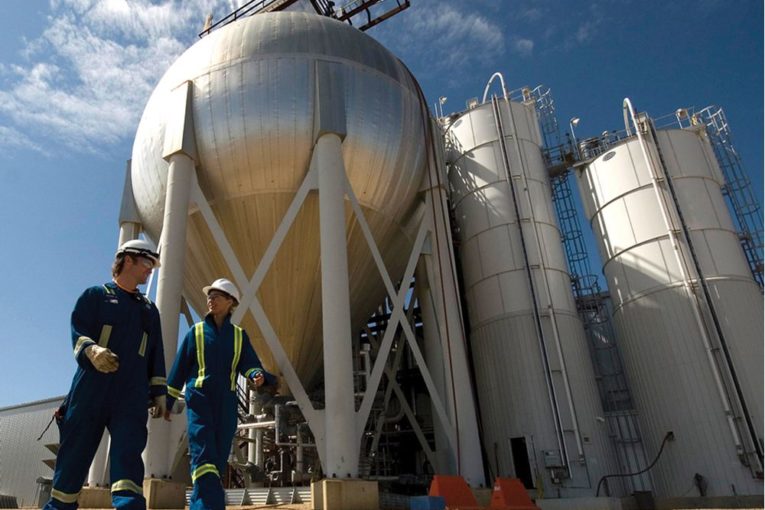
A few hours after United Conservative Party Leader Jason Kenney called on oilpatch CEOs to speak up more forcefully for their sector, the heads of five industry groups laid their election cards on the table Wednesday.
And just as the leaders representing petroleum producers, pipeline operators and the oilfield services sector began speaking in Calgary, Premier Rachel Notley announced Alberta would increase its oil production levels for February and March, easing the province’s curtailment target.
I’m not saying there’s a direct connection between these events.
(Kenney was speaking to the Calgary Real Estate Board, while Notley was responding to data showing Alberta’s oil inventories are falling faster than expected.)
What I am saying is with a provincial election around the corner — voters will head to the ballot box before the end of May — expect to see pipelines, oil curtailment, greenhouse gas emission levels, the carbon tax and industry competitiveness become major campaign themes.
Energy won’t be on the ballot box.
But this is Alberta. It won’t be far from the conversation, as all sides look for ways to kick-start investment and employment in the province’s largest and most powerful sector.
“It really is a watershed moment,” Chris Bloomer, CEO of the Canadian Energy Pipeline Association, said in an interview.
“We are getting pounded from all sections, the pushback is not abating and we need to make our voices heard.”
The unusual joint news conference by the industry groups was designed to discuss the role energy issues should play in the upcoming election campaign.
The sector is grappling with an array of concerns: difficulty getting oil and gas to market, feeble commodity prices, the relocation of rigs to the United States, shrinking capital programs, reduced drilling activity and challenges attracting investment.
The most immediate problem is getting pipelines built to move oil and natural gas out of Alberta, although the government has limited ability to influence the federal approval of projects that cross provincial boundaries.
The gridlock now facing the Trans Mountain and Keystone XL pipeline projects, along with the death of Northern Gateway and Energy East, have left the industry with too much production — about 3.9 million barrels per day (bpd) of capacity in Alberta — and not enough ways to ship it out.
It’s put a spotlight on the regulatory and legal obstacles surrounding the construction of energy infrastructure in Canada.
The transportation bottleneck led to a steeper price discount for Canadian crude last fall, prompting the Notley government to restrict oil output by 325,000 bpd, beginning this year, to rebalance the market.
The province announced Wednesday it will increase industry output by 75,000 bpd to a total of 3.63 million bpd in February and March. It’s an encouraging sign as oil inventory levels across Alberta have dipped by about 15 per cent since December.
“What we found is the (oil) storage that we had is drawing down a little faster than anticipated,” Energy Minister Marg McCuaig-Boyd said in an interview.
“But we are not out of the woods yet.”
Many producers called for curtailment to prop up sagging prices, although oilfield service firms have been hurt by its effect on capital programs.
Earlier this week, the Petroleum Services Association of Canada lowered its drilling forecast by 15 per cent to 5,600 wells for the year.
“The idea of finding a rational way to get out of curtailment would be a good idea,” said PSAC president Gary Mar.
“This is not a hypothetical issue, this is people losing their jobs . . . For the people who are the energy services workers, curtailment has not been a very good program.”
The debate over curtailment and the province’s carbon tax — some large oilsands producers such as Suncor Energy and Shell Canada have backed it, while the Explorers and Producers Association of Canada (EPAC) opposes the levy — highlight the fact the industry isn’t monolithic.
However, it has plenty in common, such as concerns over regulatory timelines to move major projects through government approval processes.
For example, it took Imperial Oil almost five years from the time it first applied for its $2.6-billion Aspen oilsands project until it was approved by regulators last October.
Tim McMillan, president of the Canadian Association of Petroleum Producers, believes improved efficiency could cut regulatory costs in Alberta by $2 billion. The payoff is the industry could double oilpatch investment in the province by 2020 if it gets the conditions right, he said.
For the drilling and services sector, the financial pressure is intense. If producers aren’t spending money, oilfield services firms aren’t working.
In 2014, the industry had a fleet of about 850 drilling rigs in the country. The Canadian Association of Oilwell Drilling Contractors expects it will fall to 500 by the end of the year.
“It’s a function of poor economics, commodity prices have certainly slumped, but it also falls squarely on government policy,” said CAODC president Mark Scholz.
The effect of these interconnected issues stretches from the oilfields to the downtown head offices. Every active drilling rig directly and indirectly employs an estimated 140 people.
ATB Financial said in a note Wednesday that head office employment in Calgary fell by almost eight per cent between 2012 and 2017, while dropping in Edmonton by five per cent.
“This isn’t just about the energy companies, this isn’t just about producing,” added Tristan Goodman, president of the Explorers and Producers Association of Canada.
“This is where teachers get their dollars from, this . . . provides good health care. It’s the actual economic engine that is driving us forward — and right now it is in crisis.”
It’s often said never let a good crisis go to waste.
The upcoming election should test that theory, with a big opportunity to examine the future of energy development in Alberta.
Chris Varcoe is a Calgary Herald columnist.
You can read more of the news on source
